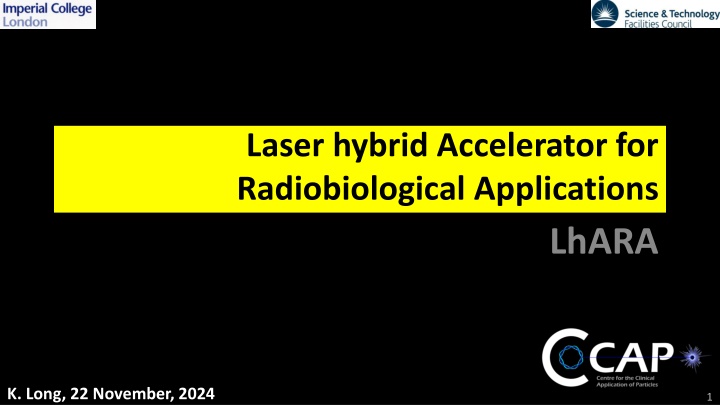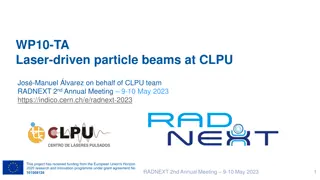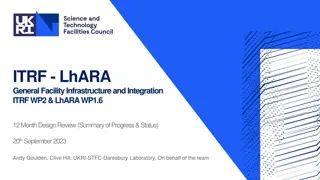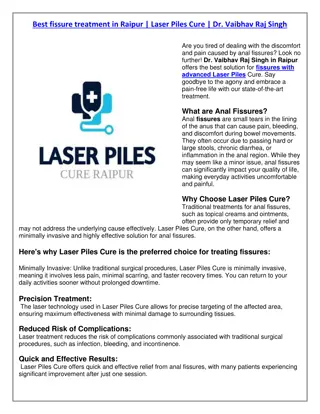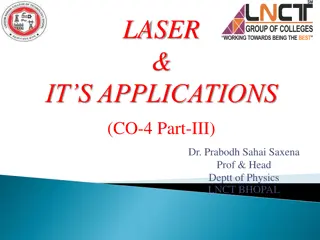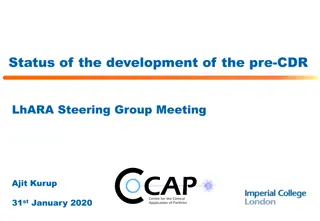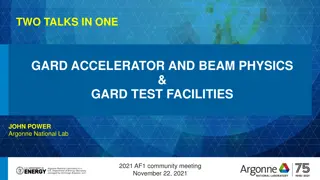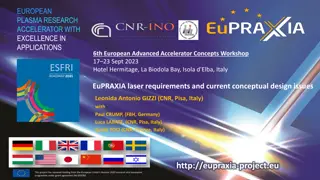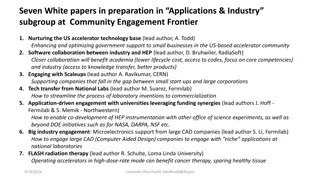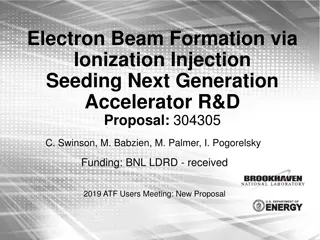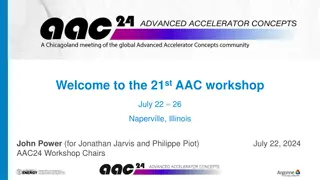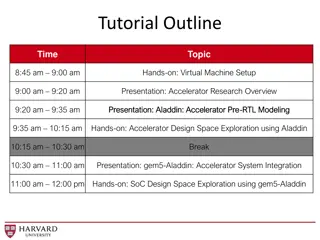Laser Hybrid Accelerator for Radiobiological Applications (LhARA) - Advancing Cancer Treatment
The Laser Hybrid Accelerator for Radiobiological Applications (LhARA) project aims to enhance cancer treatment by developing advanced medical accelerators. Collaborating with key partners and researchers, LhARA focuses on innovative techniques to address the increasing demand for radiotherapy in cancer patients. By integrating novel technologies like charged particles and on-treatment imaging, this project presents a significant opportunity to revolutionize radiobiology and improve patient outcomes.
Download Presentation

Please find below an Image/Link to download the presentation.
The content on the website is provided AS IS for your information and personal use only. It may not be sold, licensed, or shared on other websites without obtaining consent from the author.If you encounter any issues during the download, it is possible that the publisher has removed the file from their server.
You are allowed to download the files provided on this website for personal or commercial use, subject to the condition that they are used lawfully. All files are the property of their respective owners.
The content on the website is provided AS IS for your information and personal use only. It may not be sold, licensed, or shared on other websites without obtaining consent from the author.
E N D
Presentation Transcript
Laser hybrid Accelerator for Radiobiological Applications LhARA K. Long, 22 November, 2024 1
Acknowledgements Principal partners/collaborators (and level of commitment) The two early career researchers that will be recruited through the present proposal will join the CCAP LhARA design team to leverage the work of the experienced researchers at Imperial and within the CCAP. Personnel from the proto-coalition support the work proposed here. The early career researchers will be able to call on advice from personnel within the institutes that form the proto-coalition. CCAP LhARA D. Colling1a, O. Ettlinger1b, S. Gruber2, C. Hunt1a, A. Kurup1a, H.T. Lau1a, design team Z. Najmudin1b, J. Pasternak1a, J. Pozimski1a Proto-coalition: M. Borghesi1,B. Bingham2,C. Brenner3, P. Burrows4, T. Greenshaw5, D. Georg6, D. Gujral7, C. Hardiman8, K. Kirkby9, R. McLauchlan8, P. McKenna2, J. Parsons10, K. Prise11, P. Ratoff12, S. Smith13, J. Thomason14, P. Weightman5 1. Centre for Plasma Physics, Centre for Advanced and Interdisciplinary Radiation Research, School of Mathematics and Physics, Queen's University, Belfast 2. Department of Physics, University of Strathclyde, Glasgow 3. Central Laser Facility, STFC Rutherford Appleton Laboratory, Harwell 4. John Adams Institute, Department of Physics, the University of Oxford, Oxford 5. Department of Physics, University of Liverpool, Liverpool 6. Christian Doppler Laboratory for Medical Radiation Research for Radiation Oncology, Medical University of Vienna 7. Department of Oncology, Imperial College Healthcare NHS Trust, Charing Cross Hospital, London 8. Radiotherapy Department, Imperial College Healthcare NHS Trust, Charing Cross Hospital, London 9. Division of Cancer Sciences, University of Manchester and The Christie Hospital, Manchester 10. Institute of Translational Medicine, University of Liverpool, Liverpool 11. Centre for Cancer Research and Cell Biology, Institute for Health Sciences, School of Medicine, Dentistry and Biomedical Sciences, Queen's University, Belfast 12. Cockcroft Institute, SciTech Daresbury, Daresbury 13. Accelerator Science and Technology Centre and STFC Daresbury Laboratory, Warrington 14. ISIS Department, STFC Rutherford Laboratory, Harwell Department of Physics: High Energy Physics; Laser/Plasma 1 Dept. of Physics, Imperial College London 2 Christian Doppler Laboratory for Medical Radiation Research for Radiation Oncology, Medical University of Vienna 9 9 9 2 Please note the accompanying Scientific Justification can be used to expand on any information given here as required, however the main focus of it should be the scientific justification of the research.
Medical accelerators; the challenge Radiotherapy, indicated in half of all cancer patients Significant growth in demand anticipated: 14.1 x 106 new cases in 2012 24.6 x 106 by 2030 8.2 x 106 cancer deaths in 2012 13.0 x 106 by 2030 Demographic: Projections above based on reported cases (i.e. HIC) Opportunity to save 26.9 x 106 lives in LMIC by 2035 Scale-up in provision: Requires development of new and novel techniques Atun, Lancet Oncol. 2015 Sep;16(10):1153-86 3
Medical accelerators; the opportunity R&D programme: Incremental development of current practice System approach: robust, flexible next-generation facilities Multi-disciplinary R&D to harness novel techniques Opportunity: contribute to underpinning science: Radiobiology: especially charged particle (p, ion) In-situ dose-deposition imaging: especially p, ion Integration of on-treatment imaging, simulation, planning 4
Particle beam therapy Proton: Mostly cyclotron-based Issues: Energy modulation; Shielding Source: Injector per ion species Limit to instantaneous dose rate MedAustron Facility Christie Proton & ion (carbon): Synchrotron based: Issues: Energy modulation Source: Injector per ion species Limit to instantaneous dose rate MedAustron 5 MedAustron designed to deliver both proton/carbon, began treatments with protons in 2016. 4 rooms: T1 is the research room, T2 + T3 are the patient treatment rooms, T4 is still waiting to be commissioned. 2/8
Design of LhARA-Laser hybrid Accelerator for Radiobiological Applications C. Hunt*, O. Ettlinger, A. Kurup, H. T. Lau, K. Long, Z. Najmudin, Imperial College London, London, UK J. Pasternak , J. Pozimski, Imperial College London, London, UK and STFC/RAL, UK END STATION Where the cells will be irradiated. The beam will be delivered vertically from below the cell culture plate. ABSTRACT Recent interacting with targets for the creation of ion beams offer a possibility to provide beams for radiobiology research. This research aims to precisely study effectiveness of charged particles on various cultures of cells, which is essential to inform next generation hadron therapy treatment plans. The Laser hybrid Accelerator for Radiobiological Applications (LhARA) has been proposed to use a laser driven beam, which will be captured and focused using Gabor Lenses. The beam will be then energy and momentum selected to create a beam for in- vitro cells studies or sent to a post-accelerator ring to create beam for in-vivo studies. The optical design of LhARA is presented in this paper. Motivation A detailed systematic study of the relative biological e f f e c t i v e n e ss (RBE) for protons and heavier ions, under d i f f e r e n tphysical conditions, with different tissue types could enable to improve treatment planning protocols in hadrontherapy. Novel laser driven sources provide multi-ion beams y developments of using lasers z LASER TARGET Laser used to generate intense ions beams and beams of different types of ions, e.g. protons and carbon ions. beam the radiobiological ENERGY SELECTION A Gabor lens and a collimator slit are used to select particle energy, as the focal point of the Gabor lens is energy dependent. laser45 90 VERTICAL BEND Combined function sector magnets and collimators are used to select momentum and deliver the beam vertically to the end stations. 11.58m CAPTURE SECTION Gabor lenses used for compact focussing to capture the large divergence and energy spread of the laser driven ion beam. MATCHING Two Gabor lenses are used to adjust the beam size and divergence in the end station. LhARA lattice design Input beam will plastic foil Highly divergent beam will be captured using a very strongly focusing Gabor lenses, Beam will be focused strongly back on the collimator, which will reduce the energy spread. Downstream the collimator Gabor lenses will provide a beam matching A vertical achromatic 90 bend will enable to transport the beam to the radiobiological experiment, while selecting particle momentum. come from laser irradiating a thin Laser-driven proton/ion source with flexible dose capabilities. LASERSOURCE Advantage: Enormous proton/ion flux at 10 15MeV in tint (30 fs) pulse Positive ions from hydrocarbon contamination on the target surface Energy vs angle with respect to laser beam direction LASER + + + + + + + + + + END STATION - - - - - 10 mm Material budget determines required beam energy. More material increases cost of laser. Consider cell sample containers. 15 mm cell nutrient solution. G4_WATER - Electron sheath generated by the laser accelerates positive ions from the target - - 0.03 mm cell layer. G4_SKIN_ICRP 1.15 mm sample container base. G4_POLYSTYRENE Issue to be solved: Efficient capture, focusing, selectin and manipulation of divergent ion beam multiple species, e.g. proton and carbon ions. Produces intense beams and Laser driven ion beam simulation using EPOCH. 5mm air gap. G4_AIR 6 GABOR LENS 0.25 mm scintillating fibre layer. G4_POLYSTYRENE Energy deposition and dose calculation very important for the design of the end station. Want the Bragg peak in the cell layer. Ensure efficient delivery of dose to the cells (i.e. minimize the time needed to irradiate a sample). BDSIM provides energy loss along beam direction. cylindrical anode Solenoid coils Grounded end plate Grounded end plate 0.075 mm vacuum window. G4_MYLAR Ion beam Electron cloud CONCLUSION AND FUTURE PLANS The LhARA facility aims to explore novel accelerator technologies to deliver intense beams of protons and ions from helium to carbon. The optics design of the beam-line for the first stage of LhARA has been created. This stage of the facility aims to explore beam energies in the range 12 15MeV allowing cells to be irradiated before and within the region of the Bragg peak. It may also commission the ion beams needed for Stage 2 of the facility. The optics design will be followed by dedicated beam dynamics studies including tracking studies with and with-out space charge effects, which will help to verify the performance of the facility. In parallel, Stage 2 of the facility will be designed including an FFA based post-accelerator. beam The Gabor lens uses a plasma to generate a strong electro-static focusing field. Assembled lens prototype will be tested at Imperial. Energy loss as a function of depth for different beam energies 10 MeV Energy loss [GeV/0.02mm] 12 MeV 15 MeV Depth [mm] beam 0.25 mm scintillating fibre layer 1.15 mm sample container base 15 mm cell nutrient solution 0.075 mm vacuum window 0.03 mm cell layer 5 mm air gap
LhARA: ion-source development Laser source/capture test Electron cloud Ion beam cylindrical anode Solenoid coils Capture Electron plasma: Strong focusing of +ve ions Grounded end plate 8 8 8 8 8 8 8 8 8 8 8 8 8 8 8 8 Grounded end plate U U U U U U U U U U U U U U U U 1st prototype: 1 MeV protons Surrey Ion Beam Centre Aberrations observed Integration test: Gabor lens on Serberus Laser at Imperial Plan: Upgraded prototype: Under test, Imperial Now : validate lens with source Summer: test using laser-driven source 7
Laser-hybrid Accelerator for Radiobiological Applications LhARA; a novel, hybrid, approach: High-flux, laser-driven proton/ion source; Novel plasma (Gabor) lens capture & focusing Post-acceleration and phase rotation: FFA &/or SC RF Unique features: Very large flux of p or ions in very short pulses: Enormous instantaneous dose Inject at ~15 MeV into first accelerating structure Overcomes space-charge limit of today s ion sources Staged implementation: In-vitro studies permitted at 15 MeV: Source, capture, transport In-vivo studies using post-accelerator (127 MeV p; ~35 MeV/u) Uniquely flexible radiobiology facility: Many ions, proton to carbon, in single facility Wide range of energy and dose rate, allows UHDR/FLASH radiotherapy Technologies can be developed to create uniquely flexible therapy facility 8
LhARA; stage 1 Pasternak 10 mm 10 MeV 15 mm 12 MeV cell nutrient solution. 15 MeV 0.03 mm cell layer. 1.15 mm sample container. 5 mm air gap. beam 0.25 mm scintillating fibre layer. 0.075 mm vacuum window 0.25 mm scintillating fibre layer 1.15 mm sample container base 5mm air gap 15 mm cell nutrient solution 0.03 mm cell layer 0.075 mm vacuum window. Vertical arc Laser Capture @ 10 15 MeV Energy selection Phase-space matching 11.6 m 9
Conclusions Laser-hybrid approach has potential to: Overcome dose-rate limitations of present PBT sources; Deliver uniquely flexible facility: Range of ion species, energy, dose, dose-rate Disruptive/transformative approach for 2050 Opportunity: Develop and prove novel systems in production system; Deliver research facility dedicated to radiobiology; Contribute to study of biophysics of charged-particle beams First and next steps: Initial concept developed and prototype evaluation underway Working towards CDR for LhARA GSI/FAIR, this workshop, wonderful opportunity to seek synergies! 10
